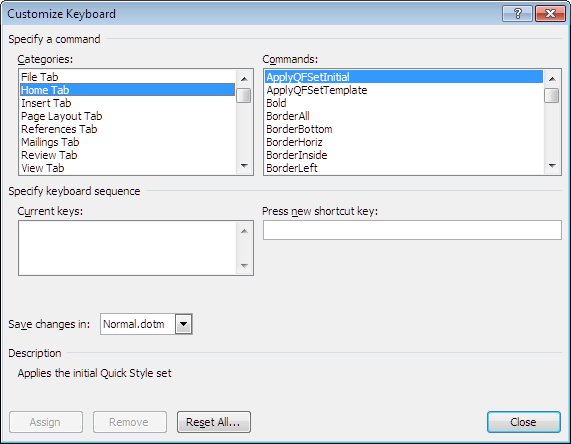

In C and many other programming languages the escape sequence \t can be used to put this character into a string literal.
SET TABS IN WORD SHORTCUT CODE
The most known and common tab is a horizontal tabulation (HT) or character tabulation, which in ASCII has the decimal character code of 9, and may be referred to as Ctrl+ I or ^I.

Because of this, many text editors have an option that makes the tab key insert the number of whitespace characters that a tab character is set to be equivalent to (by default mostly four). Some programmers and programming languages prefer the usage of multiple whitespace characters instead for that purpose.
SET TABS IN WORD SHORTCUT SOFTWARE
In software engineering, when developing computer programs or storing and manipulating data in files, the Tab character is often used for indentation purposes to help guide the flow of reading and add semantic structure to the code or data. For single player games it is also used to show the world map or the player's inventory (or some other useful info).
SET TABS IN WORD SHORTCUT PC
In PC video games, the Tab key is very often used to show scores in multiplayer games. Tab completion is more common on Linux, Unix, and Unix-like systems than Windows. On some systems, even if your input is ambiguous, tab completion may give you a list of possible options to select from. If there is no ambiguity about your intent, the rest of the characters will appear automatically. For example, in some command-line interfaces, you may type the first few characters of a command or file-name, then press Tab. On macOS, this is an option called "Full Keyboard Access".Ī feature called tab completion can be used to complete a partially typed piece of text. In many graphical applications, especially on Windows, the Tab key will move the focus to every control or widget such as buttons so that the user interface can be used without a mouse at all (this was part of the IBM Common User Access design). When filling out a computerized form, pressing Tab will sometimes move the cursor to the next field (and Shift-Tab will move the cursor to the previous field), eliminating the need to use a mouse to click in an adjacent field. In word processing and text editing, the Tab key will move the insertion point to the next tab stop in a table, insert the ASCII tab character, or insert multiple space characters (depending on the program used). These keys, if present, are typically labeled tab set and tab clear. In 1940, James Koca filed for a patent on a mechanism allowing the tab stops for each column to be set and cleared from the keyboard, eliminating the need for the typist to bend over the back of the machine to directly manipulate the tab rack. To set or reset a tab for a particular column, the tab stop for that column was simply rotated in or out of engagement. Initially tab stops were set by adding and removing clips from the tab rack, but Edward Hess working for the Royal Typewriter Company filed for a patent in 1904 covering a system where the tab stops were permanently mounted on the tab bar. Pressing 10 advanced to the space before the tab, pressing 100 advanced to the position 2 spaces before the tab. For example, in 1903, Harry Dukes and William Clayton filed for a patent on a tab mechanism with multiple tab keys numbered 1, 10, 100, etc. Various schemes for numeric tabs were proposed. Tabbing to this location and then pressing the backspace key to back up to the position of the first digit is practical but slow. For numeric data, however, the logical place for the tab stop is the location of the least significant digit.

Often a first tab stop at 5 or 6 characters was used for this, far larger than the indentation used when typesetting. The tab mechanism came into its own as a rapid and consistent way of uniformly indenting the first line of each paragraph. Fredric Hillard filed a patent application for such a mechanism in 1900. The original tabulator stops were adjustable clips that could be arranged by the user on the tabulator rack. Pressing the tab key would advance the carriage to the next tabulator stop. To simplify this, a horizontal bar was placed in the mechanism called the tabulator rack. The word tab derives from the word tabulate, which means "to arrange data in a tabular, or table, form." When a person wanted to type a table (of numbers or text) on a typewriter, there was a lot of time-consuming and repetitive use of the space bar and backspace key. On this machine, the tab-rack is removable for easy reconfiguration. The tab rack from a Flexowriter model 2201.


 0 kommentar(er)
0 kommentar(er)
